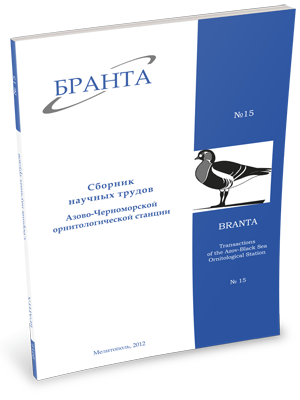
Transactions
of the Azov-Black Sea Ornithological Station



Importance of limans and lagoons of the Azov-Black Sea Region for the realization of migratory strategy of tundra waders
T. A. Kirikova
The studies were carried out for 13 species of tundra waders on their stopovers – limans of the Sea of Azov (Molochnyi Liman), limans of the Black Sea (Tuzlovska group of limans and Tilihulskyi Liman), and in Syvash lagoons (Eastern and Central Syvash). The aim of the research was to determine the importance of limans and lagoons of the region for the realization of migratory strategy of tundra waders in the Azov-Black Sea Region.
Taking into account that the number of waders during one migratory season depends on many factors we, nevertheless, have used correlation analysis making an attempt to establish relationships between the number of tundra waders on stopovers of the Azov-Black Sea Region and two factors characterizing any available feeding site – biomass of prey items and size of the area. It allowed us to suppose what factor of these can have a critical importance for the selection of a stopover by migrants at limans and lagoons, and also to refine status of stopovers in South Ukraine for longdistance migrants as sites of replenishment and accumulation of energy reserves.
Correlation analysis was done using the programme Statistica 6.0 (StatSoft Inc., 2001). All correlation relationships were statistically reliable, P≤0.05. Only strong and average correlation coefficients were analyzed. Analysis of the relationships between foraging capacity of limans (macrozoobenthos biomass) and average seasonal numbers of birds has shown that stopovers of most species of tundra waders (except for those which have prenuptial or post-nuptial moult there) more correspond to short stops for having rest and quickly replenishment of spent energy reserves. Analysis of the relationships between foraging capacity of lagoons (macrozoobenthos biomass and size of feeding area) and average seasonal numbers of birds has shown that, contrary to limans, Syvash lagoons fully realize migratory strategy of the tundra waders using both short- and long-distance flights. Syvash lands are important not only as sites for accumulation and replenishment of energy reserves during stopovers but also as sites for compensation energy reserves during moult (Dunlin populations). According to Warnock’s classification (Warnock, 2010) the Azov-BlackSea limans can be considered as «stopovers», and lagoons of Eastern and Central Syvash as «staging sites» (Table 3). Syvash is the most important stopover area which we refer as «staging sites» for tundra waders along the Mediterranean flyway, similar to WaddenSea in the East Atlantic flyway (Goede et al., 1990; Meltofte et al., 1994; Piersma et al., 1994).
The factor, which determines the spatial distribution and number of tundra waders, at Syvash is the size of feeding area, and at limans – food abundance. Changes in forage conditions of Syvash lagoons: reduction of suitable feeding areas, decrease in biomass of valuable prey - Hediste diversicolor (Kirikova, Antonovsky, 2010; Kirikova, Antonovsky, 2011) in case of absence of equal stopover areas along the Mediterranean flyway can lead to reduction in numbers of migratory waders.
Read the paper in a PDF file